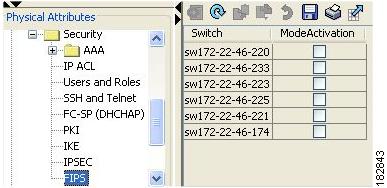- Device Manager Help
- Configuring Cisco DCNM-SAN Server
- Configuring Authentication in Cisco DCNM-SAN
- Configuring Cisco DCNM-SAN Client
- Device Manager
- Configuring Performance Manager
- Configuring High Availability
- Configuring Trunking
- Configuring PortChannels
- Configuring N Port Virtualization
- Configuring Interfaces
- Configuration of Fibre Channel Interfaces
- Using the CFS Infrastructure
- Configuring SNMP
- Configuring Domain Parameters
- Configuring and Managing Zones
- Configuring FCoE
- Configuring Dense Wavelength Division Multiplexing
- Configuring and Managing VSANs
- Discovering SCSI Targets
- Configuring SAN Device Virtualization
- Configuring Fibre Channel Routing Services and Protocols
- Managing FLOGI, Name Server, FDMI, and RSCN Databases
- Configuring FICON
- Creating Dynamic VSANs
- Distributing Device Alias Services
- Configuring Advanced Fabric Features
- Configuring Users and Common Role
- Configuring Security Features on an External AAA Server
- Configuring Certificate Authorities and Digital Certificates
- Configuring FC-SP and DHCHAP
- Configuring Cisco TrustSec Fibre Channel Link Encryption
- Configuring FIPS
- Configuring IPv4 and IPv6 Access Control Lists
- Configuring IPsec Network Security
- Configuring Port Security
- Configuring Fabric Binding
- Configuring FCIP
- Configuring the SAN Extension Tuner
- Configuring iSCSI
- Configuring IP Services
- Configuring IP Storage
- Configuring IPv4 for Gigabit Ethernet Interfaces
- Configuring IPv6 for Gigabit Ethernet Interfaces
- Configuring SCSI Flow Services
- Configuring SCSI Flow Statistics
- Configuring Fibre Channel Write Acceleration
- Monitoring the Network
- Monitoring Performance
- Configuring Call Home
- Configuring System Message Logging
- Scheduling Maintenance Jobs
- Configuring RMON
- Configuring Fabric Configuration Server
- Monitoring Network Traffic Using SPAN
- Monitoring System Processes and Logs
- Configuring QoS
- Configuring Port Tracking
- Configuring FlexAttach Virtual pWWN
- Configuring Interface Buffers
- Verifying Ethernet Interfaces
Configuring FIPS
The Federal Information Processing Standards (FIPS) Publication 140-2, Security Requirements for Cryptographic Modules, details the U.S. government requirements for cryptographic modules. FIPS 140-2 specifies that a cryptographic module should be a set of hardware, software, firmware, or some combination that implements cryptographic functions or processes, including cryptographic algorithms and, optionally, key generation, and is contained within a defined cryptographic boundary.
FIPS specifies certain crypto algorithms as secure, and it also identifies which algorithms should be used if a cryptographic module is to be called FIPS compliant.

Note Cisco MDS SAN-OS Release 3.1(1) and NX-OS Release 4.1(1b) or later implements FIPS features and is currently in the certification process with the U.S. government, but it is not FIPS compliant at this time.
Information About FIPS Self-Tests
A cryptographic module must perform power-up self-tests and conditional self-tests to ensure that it is functional.

Note FIPS power-up self-tests automatically run when FIPS mode is enabled by entering the fips mode enable command. A switch is in FIPS mode only after all self-tests are successfully completed. If any of the self-tests fail, then the switch is rebooted.
Power-up self-tests run immediately after FIPS mode is enabled. A cryptographic algorithm test using a known answer must be run for all cryptographic functions for each FIPS 140-2-approved cryptographic algorithm implemented on the Cisco MDS 9000 Family.
Using a known-answer test (KAT), a cryptographic algorithm is run on data for which the correct output is already known, and then the calculated output is compared to the previously generated output. If the calculated output does not equal the known answer, the known-answer test fails.
Conditional self-tests must be run when an applicable security function or operation is invoked. Unlike the power-up self-tests, conditional self-tests are executed each time their associated function is accessed.
Conditional self-tests include the following:
- Pair-wise consistency test—This test is run when a public-private key-pair is generated.
- Continuous random number generator test—This test is run when a random number is generated.
Both of these tests automatically run when a switch is in FIPS mode.
Guidelines and Limitations
Follow these guidelines before enabling FIPS mode:
- Make your passwords a minimum of eight characters in length.
- Disable Telnet. Users should log in using SSH only.
- Disable remote authentication through RADIUS/TACACS+. Only users local to the switch can be authenticated.
- Disable SNMP v1 and v2. Any existing user accounts on the switch that have been configured for SNMPv3 should be configured only with SHA for authentication and AES/3DES for privacy.
- Disable VRRP.
- Delete all IKE policies that either have MD5 for authentication or DES for encryption. Modify the policies so they use SHA for authentication and 3DES/AES for encryption.
- Delete all SSH Server RSA1 key-pairs.
Enabling FIPS Mode
To enable FIPS mode, follow these steps:
To enable FIPS mode using DCNM-SAN, follow these steps:
Step 1 Expand Switches from the Physical Attributes pane. Expand Security and then select FIPS.
You see the FIPS activation details in the Information pane as shown in Figure 33-1.
Figure 33-1 FIPS Activation in DCNM-SAN

Step 2 Check the ModeActivation check box next to the switch for which you want to enable FIPS mode.
Step 3 Click Apply Changes to commit and distribute these changes.
Step 4 Click Undo Changes to discard any unsaved changes.
To enable FIPS mode using Device Manager, follow these steps:
Step 1 Choose Physical > System or right-click and select Configure.
You see the System dialog box as shown in Figure 33-2.

Step 2 Check the FIPSModeActivation check box to enable FIPS mode on the selected switch.
Step 3 Click Apply to save the changes.
Step 4 Click Close to close the dialog box.
Verifying FIPS Configuration
For detailed information about the fields in the output from these commands, refer to the Cisco DC-OS Command Reference .
 Feedback
Feedback